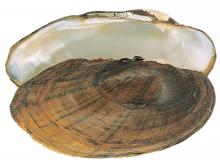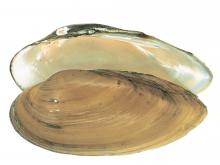Aquatic Invertebrates
Media

Species Types
Scientific Name
Lampsilis siliquoidea
Description
The fatmucket was a favorite species harvested for the button industry in the early 1900s.
Media

Species Types
Scientific Name
Quadrula quadrula
Description
The mapleleaf spawns in the summer, using catfish as a host.
Media

Species Types
Scientific Name
Utterbackia imbecillis
Description
Unlike most other freshwater mussels, this species is hermaphrodic: An individual mussel can be both male and female.
Media

Species Types
Scientific Name
Lampsilis cardium
Description
The plain pocketbook is one of the most common and widespread mussels in our state. It is oval, relatively large, and occurs frequently.
Media

Species Types
Scientific Name
Ligumia subrostrata
Description
This widespread species is one of the few Missouri mussels successful in shallow ponds and lakes.
Media

Species Types
Scientific Name
Lampsilis teres
Description
The uniform shell thickness and hard, white nacre made this mussel a favorite for button manufacturing, in the days before most buttons were made of plastic.
Media

Species Types
Scientific Name
Bivalve molluscs in order Unionoida
Description
Secretive and seldom seen, freshwater mussels are extraordinarily diverse in Missouri. We have nearly 70 species within our borders. Many are declining, and several are endangered.
Media

Species Types
Scientific Name
Dugesia, Planaria, and other genera
Description
Unlike their parasitic cousins in the flatworm group, turbellarians, or planarians, are tiny carnivores or detritus-eaters that glide smoothly across submerged leaves and other objects.
See Also
About Aquatic Invertebrates in Missouri
Missouri's streams, lakes, and other aquatic habitats hold thousands of kinds of invertebrates — worms, freshwater mussels, snails, crayfish, insects, and other animals without backbones. These creatures are vital links in the aquatic food chain, and their presence and numbers tell us a lot about water quality.





















